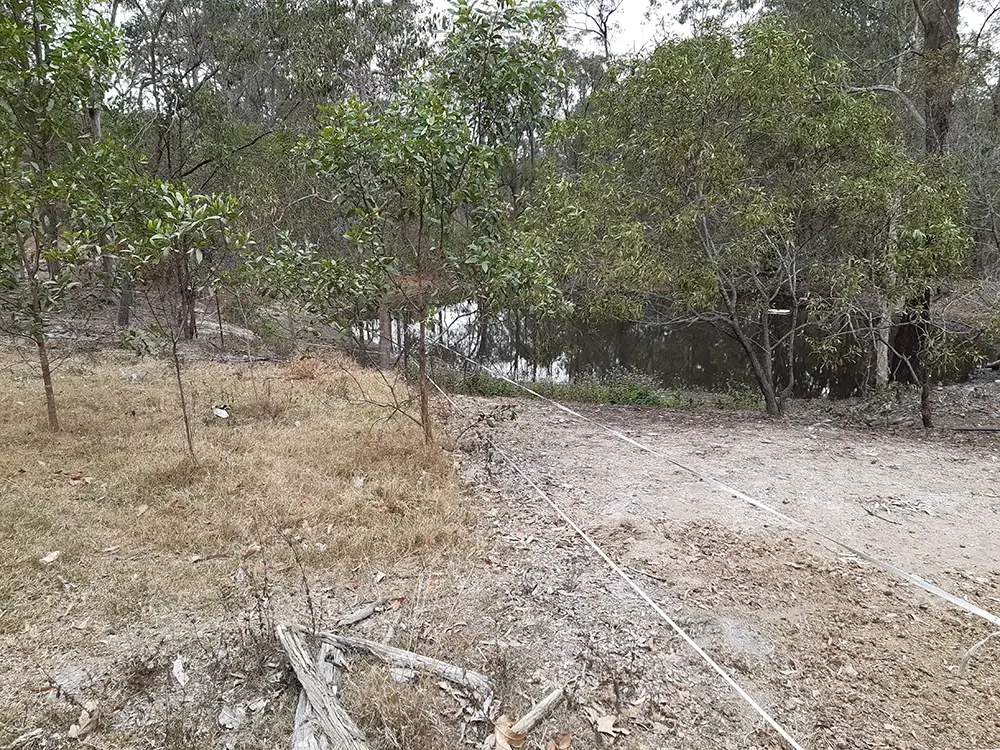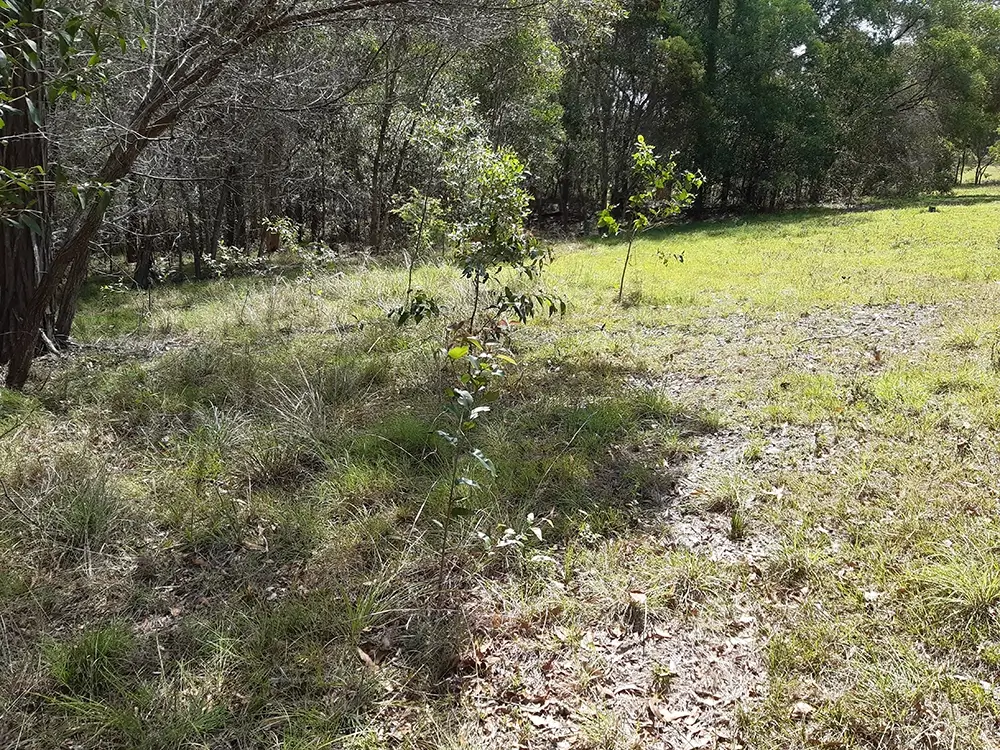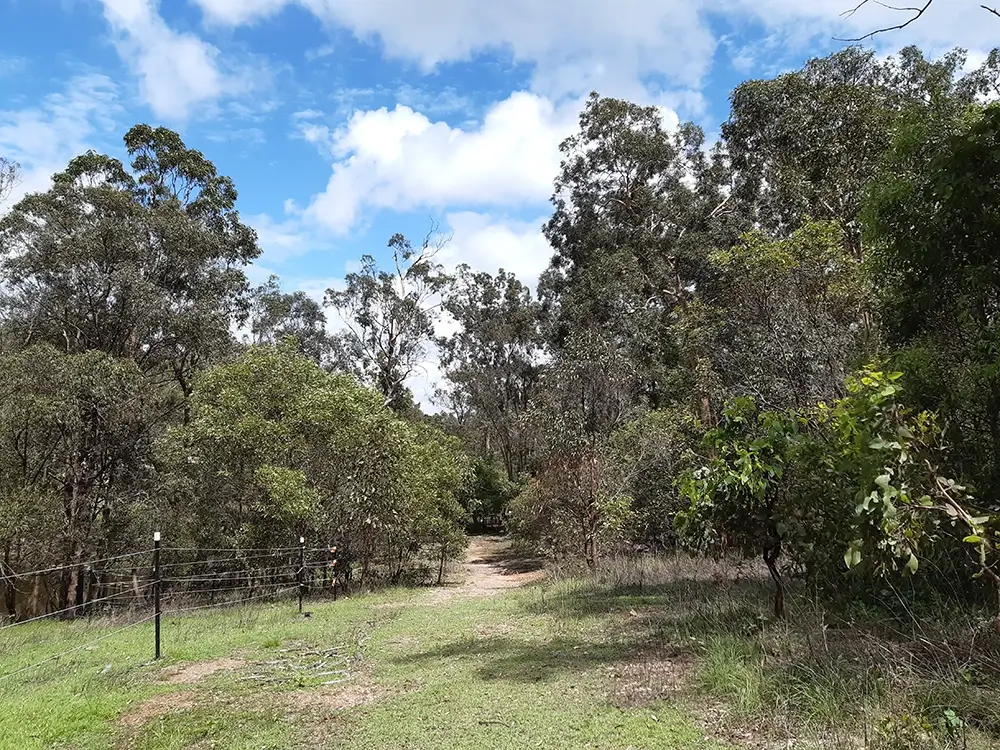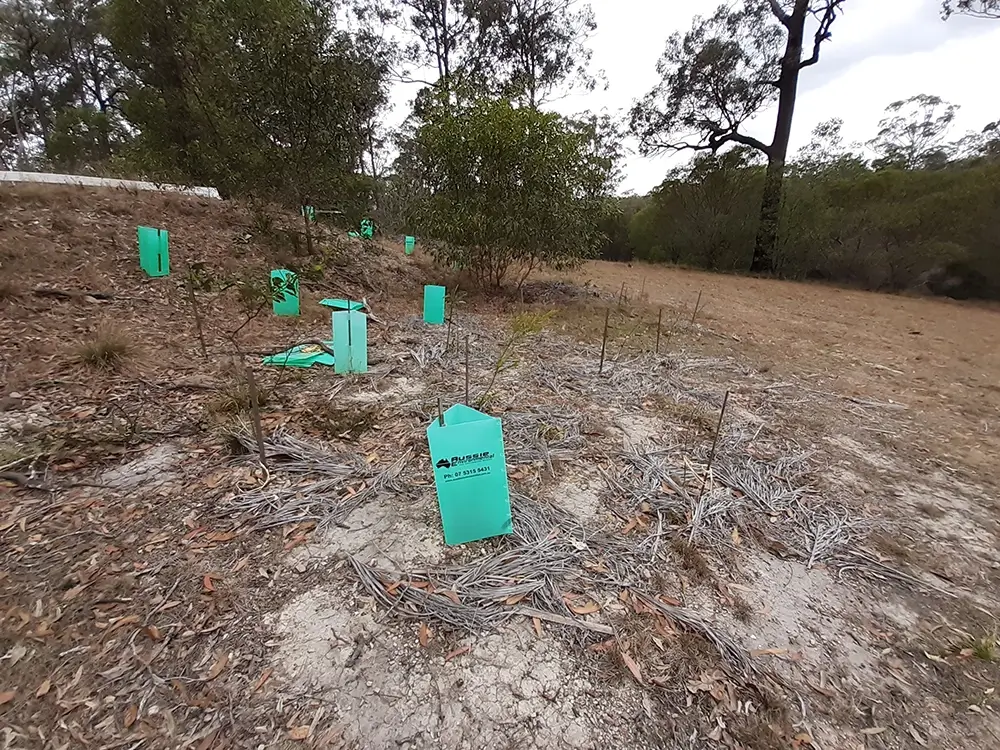The regeneration of our property has certainly been a labour of love. We are conscious that we live in an environmentally unique and fragile area. There is a lot of encroaching development and destruction of habitat, so we are keen to limit our own impact on our surrounds.
It has been wonderful to have the support of the Brisbane City Council Land for Wildlife team to help us with mass plantings, weed control and information. The Healthy Land, Healthy Horses seminar provided a wealth of information that has really assisted us in making a difference to what was formerly a dust bowl. We have loved seeing the improvements to our property. I think the natural regeneration has surprised us all. We have also observed a wealth of wildlife returning to the property from many species of birds, insects and larger mammals including wallabies, koalas and echidnas.
Exclusion fencing has been effective in keeping stock out of the dam, creek, bushland and areas that are undergoing restoration. The natural regeneration in fenced off areas has been impressive.
We have done many different activities to help restore our property. Here is a summary.
Exclusion Fencing
Using 3-strand plain wire and electric tape, we fenced off the dam and separately fenced off several corridors along the property boundary and below the dam. We prioritised fencing off the native bushland along our property boundaries that adjoin with neighbouring bushland and an ephemeral creek.
Soil Regeneration
On the bare eroded slope above the dam, we laid woody stems and fallen branches from dead wattles and weeds across the ground. This is called brushmatting. This has helped catch leaf litter and slow down overland flow, building up soil and producing excellent natural regeneration of native groundcovers and shrubs.
We applied mulch and old hay over bare dirt areas which the horses use regularly, to protect soil and encourage growth of desirable grass species.
Manure is being spread across bare patches of soil to fertilise the soil. We run the mower over it to help it break down. Old cardboard and manure are used to fertilise bare areas where shrubs and trees are being grown.
Fallen twigs and branches, leaf litter and dead palm fronds have been put to use as groundcover around new plantings in exposed areas. This has definitely helped enhance the growth of our plantings.
Revegetation
In 2022, we received Community Conservation Assistance funding from Brisbane City Council for contractors to replant a corridor of trees and shrubs along the south and northern sides to connect existing patches of native vegetation to the creek. We also planted trees and shrubs in a corridor to connect the dam to the creek.
In 2025, even more revegetation was achieved with 500 total plants, some of which were supplied through the Brisbane City Council Land for Wildlife program. Assistance with labour was generously supplied by Bulimba Creek Catchment Coordinating Committee (B4C) and SEQWater through the Upper Tingalpa Creekcare Project. The plants are now looking amazing.
Horse Management
To further improve our pastures and soils, we were inspired to implement recommendations from the Healthy Land, Healthy Horses workshop with Stuart Myers from Equiculture in Feb 2023. This was organised by Healthy Land and Water, Brisbane, Logan and Redland Councils.
During the dry of spring 2023, we completely took our horses off the pasture paddocks to allow the grass to rest and recover and to enable weed control. The horses were retained in a hardstand paddock where they were fed hay.
In the hardstand paddock, the corners were fenced off and replanted with flowering trees and shrubs. This prevents the horses from cornering each other and connects habitat for birds and pollinators across the block.
Doug installed a sprinkler system through the pasture and native pasture paddocks to keep grass watered in times of no rainfall.
Weed Control
Doug invested in a wick wiper attachment for the slasher to treat weedy grasses, namely Giant Rat’s Tail and Parramatta Grasses (Sporobolus species) in the pasture paddocks with flupropanate. Excellent early results have been achieved. Other minor weeds are also being treated with herbicide.
Natural Regeneration
The natural regeneration of native plants has been a highlight, particularly the diverse native grasses and groundcovers. The fact that our property is adjacent to bushland and that the pasture has not been heavily grazed in the past have both helped ensure good seed stock and natural regeneration. We have been delighted to find patches of delicate sundews (Drosera sp.), bluebells (Wahlenbergia sp.), Goodenias and other wildflowers.
The grazing paddocks have an excellent diversity of native grasses and sedges including Common Fringe-rush (Fimbristylis dichotoma), Barbed Wire Grass (Cymbopogon refractus), Kangaroo Grass (Themeda australis), Brown’s Lovegrass (Eragrostis brownii), Native/Hairy Panic (Panicum effusum), Wiry Panic (Entolasia stricta), Shortgrass (Paspalidium distans), Cockatoo Grass (Arundinella nepalensis) plus Digitaria and Aristida species.
In non-grazing patches, regrowth has included Whiteroot (Lobelia purpurascens), Love Flower (Pseuderanthemum variabile), Golden Buttons (Chrysocephalum apiculatum), various native peas (Glycine, Chorizema and Desmodium species), Riceflower (Pimelea linifolia), sundews (Drosera species), sedges (Lomandra, Dianella and Lepidosperma species) and Ground Berry (Acrotriche aggregata).
Article and photos by Fiona and Doug
Land for Wildlife members
Burbank, Brisbane
Laying old hay, dead palm frond, leaf litter, branches and other vegetation across the ground has helped our plantings and encouraged natural regeneration. This is called brushmatting and is a cheap and effective way to minimise soil erosion, reduce overland water flow and to help start the soil building process.
Managing healthy pasture cover, healthy horses and restoring natural habitat on small acreage properties with poor soils is a fine balancing act. Fiona and Doug from Burbank in Brisbane’s east have spent over two decades working persistently to replenish bare soil, replant and assist natural regeneration across their property. They have made great progress while raising a family, four horses, dogs and numerous chickens.
Since joining Land for Wildlife at the height of the millennium drought in 2008, they now have lush green ground cover and expanded areas of regenerating eucalyptus forest. Their property supports a horse arena, chook yard, two dams, several grazing paddocks, native pasture paddocks and a strip of regenerating riparian corridor adjoining a bushland reserve. It has been my privilege to work with Fiona and Doug, and I hope this story provides advice and encouragement to other horse and nature lovers.
Fflur Collier
Land for Wildlife Officer
Brisbane City Council






I would like to connect with Fiona and Doug. I have had light horse grazing on my property on the Sunshine ten hectares of old growth forest my mobile is 0477424780. Email ocean blue20@iinet.net.au. The old growth forest is prime koala habitat with Sydney blues and forest red gums over 50m high. Australia Zoo collects leaves for their koala hospital on a periodic basis free of charge. We have to limit the harvesting for the next generation. John Glazebrook
Hi John. We will aim to connect you with Fiona and Doug. All the best, LfWSEQ